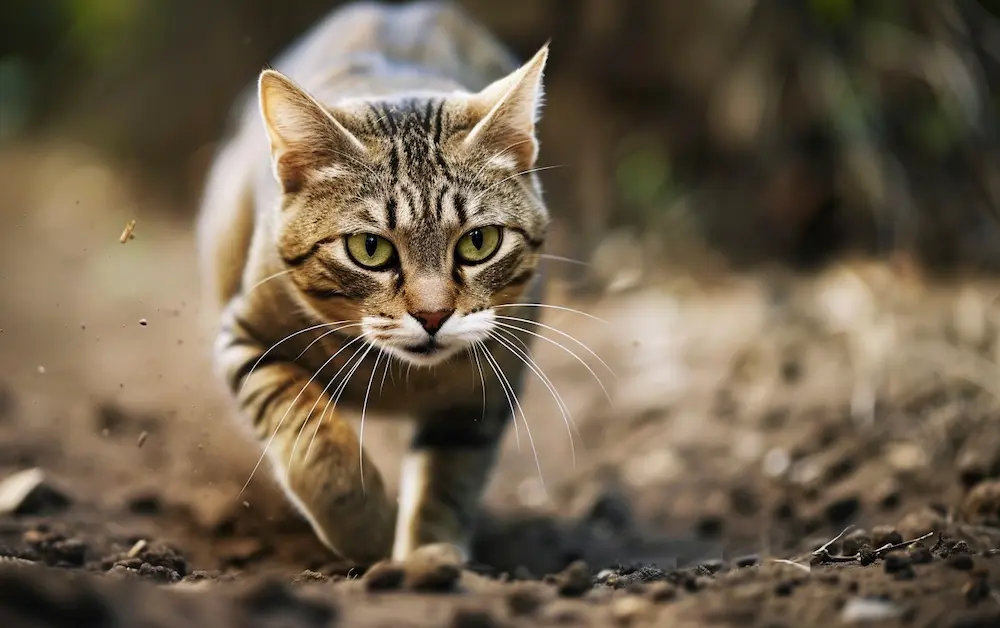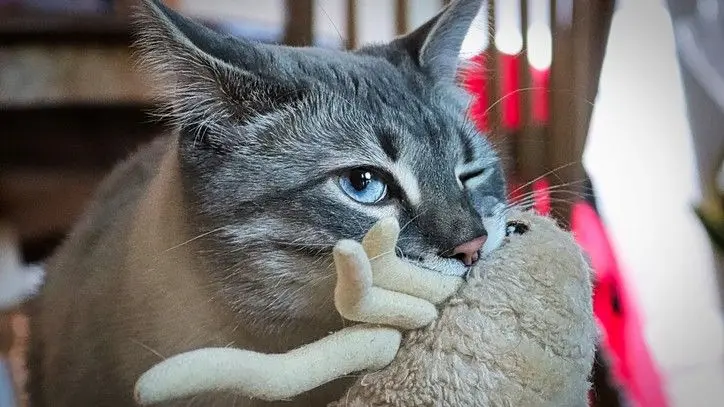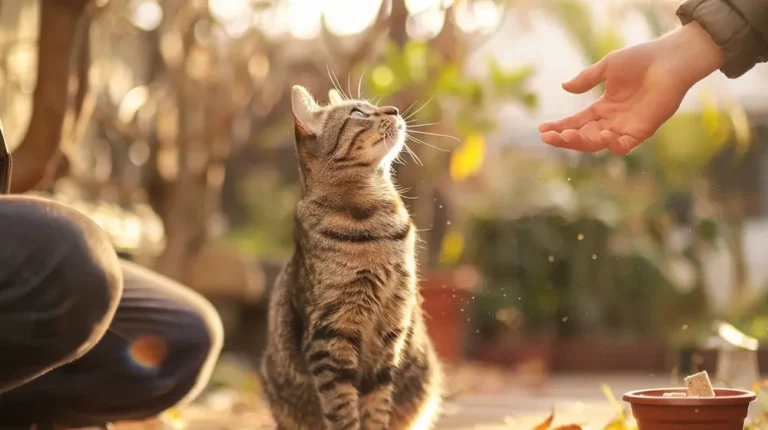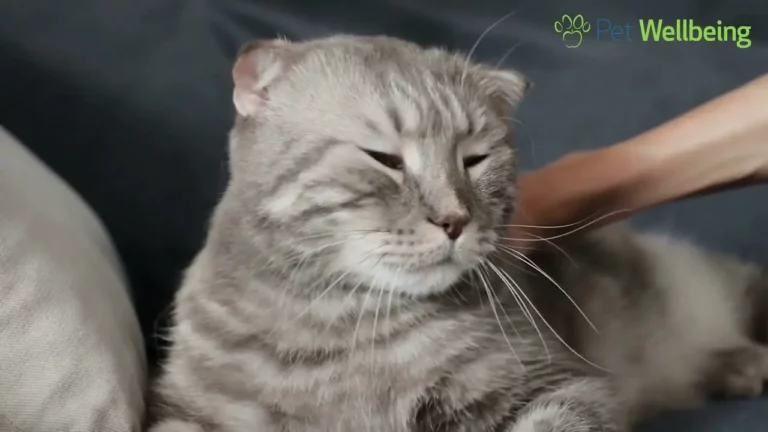5 Ways To Help Feral Cats: Here’s How To Do It!
Have you ever spotted a feral
It’s a common sight for many of us, and while our first instinct might be to feed them, there’s so much more we can do to make a real difference in their lives.
Surprisingly, a simple spay/neuter procedure can cost as little as $17 for shelters, meaning even a modest donation can dramatically change a feral
In this text, I’ll share some easy yet impactful ways to help these often-overlooked animals.
From the comfort of your own home to community involvement, you’ll discover how small actions can contribute to a significant improvement in the welfare of feral cats.
Whether you’re a
Let’s explore how we can all lend a hand to these furry friends in need.
Understanding Feral Cats
Exploring the world of feral cats, I’ve discovered a lot about their lives, how they differ from stray cats, and the challenges they face.
It’s a complex issue, but I’m here to break it down and offer some ways we can all help these often-misunderstood creatures.
The Difference Between Stray and Feral Cats
So, what sets apart a stray
It’s quite simple, yet profoundly significant.
Stray cats have had human contact before.
They might have been pets at one point, lost or abandoned, but they understand that humans equal food and often shelter.
You might see a stray
On the flip side, feral cats are the wild offspring of stray or other feral cats.
They’ve had little to no human contact, living entire lives outdoors.
Imagine walking through your neighborhood and spotting a
That’s a feral
They rely solely on their instincts to survive, making them much harder to socialize.
The Challenges Feral Cats Face
The life of a feral
Imagine having to find your own food every day, whether it’s scavenging through trash or catching small prey.
Then there’s the constant search for safe shelter, especially during extreme weather—hot summers and freezing winters can be brutal.
Also, feral cats face the threat of disease and injury without access to veterinary care. A simple wound can become life-threatening if not treated.
And then there’s the issue of overpopulation.
Without spaying and neutering, one pair of cats and their offspring can produce thousands of kittens in just a few years.
This results in more cats struggling to survive and potentially causing conflicts with humans and wildlife.
But it’s not all grim.
There are actionable steps we can take to make a difference.
Understanding feral cats is the first step toward making their lives better.
It’s about recognizing their struggles, respecting their independence, and providing help in ways that respect their wild nature.
Whether you’re an animal lover or simply someone who cares about the well-being of all creatures, there’s a role you can play in supporting these silent shadows of the night.
The Trap-Neuter-Return (TNR) Method
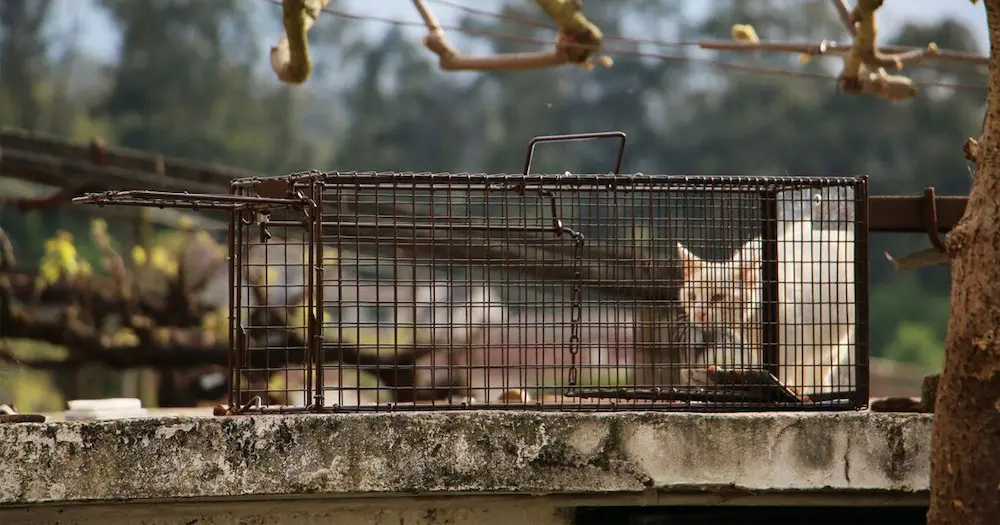
Moving deeper into our exploration of aiding feral cats, let’s jump into the Trap-Neuter-Return (TNR) method, a humane and effective strategy for managing feral
This approach not only benefits the cats themselves but also the community they live in.
I’ve gathered insights and practical advice to help you understand and possibly carry out this method in your area.
The Process of TNR
The process of TNR involves three key steps: trapping, neutering, and returning.
Firstly, feral cats are humanely trapped using cages with food as bait.
It’s important to set the traps in areas where cats frequently visit and to cover them with cloth to create a calming environment.
For example, if you’ve noticed cats congregating around a dumpster in the evening, that’s your cue to set up traps nearby around dusk.
Once trapped, the cats are then taken to a veterinary clinic or a spay/neuter facility.
There, they undergo surgery to prevent reproduction.
Male cats are neutered, and female cats are spayed.
Plus to being neutered, the cats receive a health check, are vaccinated against rabies, and are treated for any other evident medical issues.
A notable part of the process is ear-tipping – the removal of the tip of the left ear while under anesthesia – which serves as a visual indicator that a
After they recover from surgery, the cats are returned to their original territory.
Here, they can continue their lives without contributing to the population growth.
This part of the process requires careful planning to ensure cats are returned safely and to the right location.
Benefits of TNR for the Community
Implementing TNR brings multiple benefits, both for the cats and the community.
Firstly, it directly addresses the issue of overpopulation.
By neutering or spaying the cats, TNR prevents future generations of feral cats, gradually reducing the community’s feral
Besides, TNR also improves the overall health of the feral
Vaccinations and health checks during the neutering procedure help prevent the spread of diseases such as rabies and feline leukemia.
Healthier cats mean a lower risk of disease transmission to other animals and potentially humans.
Another significant advantage is the reduction in nuisance behaviors associated with feral cats, such as yowling and spraying to mark territory.
Post-TNR, these behaviors decrease substantially, leading to a more harmonious coexistence between the feral cats and the human residents.
Also, TNR fosters community engagement and cooperation.
Neighbors, local veterinarians, and animal welfare organizations often come together to carry out TNR programs.
These initiatives can strengthen community bonds and promote a culture of care and respect for all creatures.
Setting Up a Feeding Station
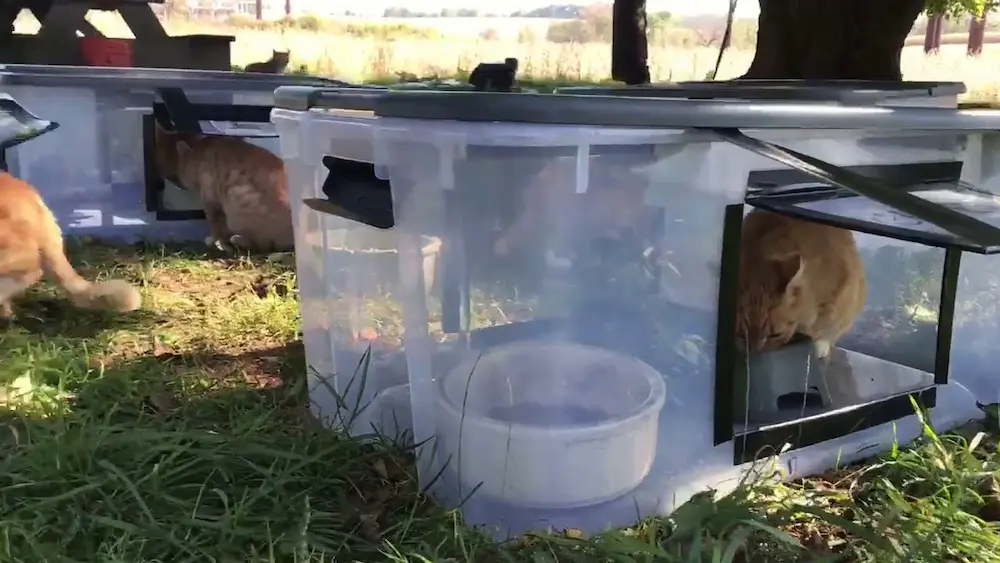
After diving into the compelling world of Trap-Neuter-Return (TNR) programs and their instrumental role in supporting feral
One vital initiative that complements TNR efforts is setting up a feeding station.
Here, I’ll guide you through creating a sustainable and safe feeding routine for feral cats, ensuring they receive the proper nutrition they desperately need.
Creating a Feeding Schedule
Consistency is key when feeding feral cats.
Establishing a set time and place for feeding not only aids in monitoring the health and well-being of the
I recommend feeding the cats once a day, either at dawn or dusk, as these times typically align with their natural hunting patterns.
For instance, if you choose to feed them every morning at 7 AM, stick to this schedule as closely as possible.
Cats are creatures of habit, and they’ll soon learn when to expect food, reducing their stress and making them more comfortable around humans.
But, it’s not just about filling a bowl and walking away.
The feeding duration is also crucial.
Allowing cats to eat as much as they can in a 30-minute window and then removing any leftovers prevents attracting unwanted wildlife or pests.
This method also encourages the cats to come to the feeding area at the scheduled time each day, which can be particularly useful for observation and TNR activities.
Besides, by feeding at a designated time and promptly clearing away uneaten food, I’ve found that it mitigates complaints from neighbors who might not be as enthusiastic about the feeding station’s location.
Ensuring Proper Nutrition

Feeding feral cats isn’t just about providing any food you can find; it’s about ensuring they receive the proper nutrition.
Hence, high-quality
While it might be tempting to opt for cheaper brands or to feed them leftovers, this can lead to nutritional deficiencies and health issues down the line.
I always opt for a mix of wet and dry food. The wet food helps keep them hydrated, especially important during the hot summer months, and the dry food assists in dental health.
Also, for those looking to go the extra mile, adding a bit of water to the dry food or offering a separate water dish alongside the feeding station encourages hydration.
A simple setup could involve two bowls under a somewhat sheltered area to protect the food and water from the elements.
Keeping the feeding station clean is also paramount.
Regularly washing the bowls prevents the spread of disease among the
Shelter Solutions for Feral Cats
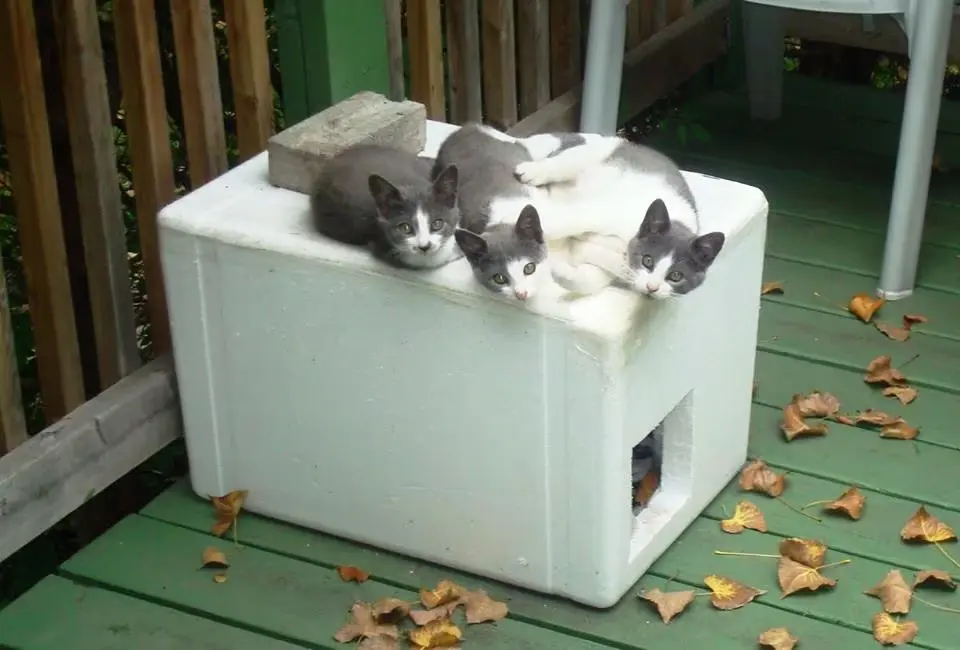
In my years of advocating and caring for feral cats, I’ve learned the significance of shelter as a cornerstone of their welfare.
After focusing on the essentials of Trap-Neuter-Return (TNR) programs and setting up feeding stations, it’s crucial not to overlook the aspect of providing shelter.
This not only ensures their safety from the elements but also aids in the overall success of TNR efforts by keeping the
Let me guide you through creating safe havens for feral cats and offer some simple shelter ideas that you can easily put together.
Providing Safe Havens in Various Weather Conditions
The need for shelter varies greatly with the changing seasons, making it essential for feral cats to have access to safe havens that can protect them against the harshness of extreme weather conditions.
During the summer, shade and ventilation are crucial to prevent overheating, while in the winter, insulation becomes the key to survival.
One of the most effective strategies I’ve employed is the placement of shelters in strategic locations that offer natural protection.
For instance, positioning shelters under trees or bushes can provide much-needed shade in summer and a barrier against snow in winter.
It’s also important to ensure the entrance faces away from prevailing winds and to elevate the shelter slightly off the ground to avoid moisture.
Simple Shelter Ideas You Can Create
Creating shelters for feral cats doesn’t have to be complicated or expensive.
In fact, with a bit of creativity, you can construct them using materials you might already have lying around.
Here are a couple of ideas that I’ve found to be effective:
- Styrofoam Coolers as Winter Shelters: These are lightweight, inexpensive, and provide great insulation. Cut a small entrance on one side, just big enough for a
cat , and line the interior with straw for additional warmth. Place the cooler in a secluded area and cover it with a heavy plastic sheet to protect from rain and snow. - Plastic Storage Bins: For a more durable option, use a large plastic storage bin with a lid. Similar to the styrofoam cooler, cut an entrance on one side and line the bin with straw. For added insulation, place a smaller bin inside the larger one and fill the space in between with straw. This double-layered approach helps in retaining heat within the shelter.
- Wooden Shelters: If you’re handy with tools, constructing a small wooden shelter can be a rewarding project. Use exterior-grade plywood for durability and be sure to water-proof the roof. Keep the design simple with a sloped roof to ensure water runoff, and remember to insulate the interior.
For all shelter types, maintaining cleanliness is key, so make sure the shelters are accessible for regular checks and cleaning.
Also, always use straw, not hay or blankets, for bedding as straw repels moisture, keeping the interior dry and warm.
Health and Safety Concerns
Taking care of feral cats goes beyond just feeding and providing shelter; it’s also about ensuring their health and safety, as well as that of our pet cats and ourselves.
From my years of experience working with feral cats, I’ve learned a thing or two about how to manage these concerns effectively.
Preventing Disease Transmission to Pet Cats
Feral cats, while resilient, can be carriers of diseases that might be transmitted to your pet cats.
But, the risk can be minimized with a few careful steps. Firstly, vaccination is key.
When participating in TNR programs, make sure the feral cats are vaccinated against common diseases such as feline leukemia virus (FeLV) and feline immunodeficiency virus (FIV).
This action alone significantly reduces the risk of disease spreading.
Keeping a distance between your pet cats and feral cats is also vital.
I know, it might be tempting to let them mingle, thinking all cats should get along, but it’s safer to keep them apart.
Ensure your pets are always up to date with their vaccinations and have regular health check-ups.
This not only keeps them safe but also gives you peace of mind.
Besides, maintaining hygiene around feeding stations and shelters is crucial.
Use gloves when handling food dishes or bedding, and wash these items regularly.
It’s a simple step, but it goes a long way in preventing the spread of diseases.
Handling Feral Cats Safely
Handling feral cats requires patience, understanding, and the right approach.
Remember, these cats are not socialized to humans, and their first instinct is to defend themselves if they feel threatened.
Hence, I always advise against trying to handle or pet feral cats directly.
When you need to transport a feral
These traps are designed to safely and respectfully capture the cats without causing harm or stress.
Once the
This simple act calms the
Wearing gloves is another precaution I never skip.
It protects me from scratches and potential infection.
It’s an essential practice for anyone working closely with feral cats.
Finally, understanding and respecting the boundaries of feral cats is paramount.
These animals are not accustomed to human touch or interaction, so always prioritize their comfort and safety over your desire to interact with them.
By following these guidelines, we can ensure not only the health and safety of feral cats but also that of our pet cats and ourselves.
It’s about coexisting with these creatures in the most respectful and safe way possible.
With patience and diligent care, we can make a significant difference in the lives of these often-misunderstood animals.
Community Involvement and Support
Caring for feral cats is not a solo mission.
It requires the combined efforts of the community and local animal organizations to truly make a difference.
Let me guide you through the process of engaging your community and collaborating with animal welfare groups.
This partnership not only amplifies the impact of your efforts but also fosters a supportive network for these often-misunderstood animals.
Building a Local Support Network
The first step towards creating a safer environment for feral cats is establishing a local support network.
This involves reaching out to neighbors, friends, and local businesses to raise awareness and seek participation.
A well-informed community can significantly contribute to the success of feral
Start by organizing a community meeting or workshop.
I’ve found that inviting a TNR expert or veterinarian to these gatherings can offer insightful knowledge and address any concerns people might have about feral cats.
For example, they can explain how TNR helps control the
Besides, consider creating a neighborhood watch program for feral cats.
This can involve setting up feeding stations in safe areas and monitoring the health and well-being of the colony.
Tools like social media groups or messaging apps can keep everyone in the loop about any cats that need attention or when a new
Collaborating with Animal Welfare Organizations
Collaborating with established animal welfare organizations can drastically elevate your efforts to help feral cats.
These organizations often provide essential resources, such as spay/neuter services, educational materials, and even grants for community TNR projects.
Let’s say you’re ready to conduct a TNR project. Reach out to local shelters and rescue groups for support.
Many shelters offer trap rental services, and some might even provide a volunteer veterinarian for your TNR day.
They can also guide you on the proper aftercare for cats that have been neutered, ensuring a safe and healthy recovery before their return to the wild.
Don’t hesitate to seek advice from these organizations on setting up winter shelters or creating an effective feeding schedule.
They’ve likely encountered almost every scenario imaginable and can offer solutions that you might not have considered.
Also, consider partnering with these organizations for fundraising events. Not only does this raise necessary funds for your TNR projects, but it also increases community engagement and awareness about the plight of feral cats.
Events like bake sales, charity runs, or even online campaigns can have a significant impact.
To conclude, supporting feral cats is a community effort that benefits from the engagement and cooperation of every stakeholder.
By building a local support network and collaborating with animal welfare organizations, you’re creating a foundation for sustainable care and compassion towards these cats.
Remember, every effort counts, and together, we can make a meaningful difference in the lives of feral cats.
Legal Considerations and Ethical Issues
Moving forward from understanding the necessity of community involvement and the effectiveness of Trap-Neuter-Return (TNR) programs, it’s crucial to investigate into the legal and ethical frameworks that guide our actions towards feral cats.
The balance between law and morality plays a significant role in shaping our approach to feral
Understanding Local Laws on Feral Cat Care
First off, let me stress how important it is to become well-acquainted with your local laws about feral cats.
Laws can greatly vary not just from one country to another, but also between states, counties, or even cities within the same state.
For instance, some areas have embraced TNR programs and actively support them, recognizing their value in managing feral
On the other hand, there are places where feeding feral cats is discouraged or outright illegal, based on the belief that it encourages more cats to become reliant on human support.
Hence, before you start feeding a colony or attempting to initiate a TNR program, a bit of assignments is necessary.
A quick call to your local animal control office or a visit to their website can provide you with the information you need.
This step not only ensures that you’re helping the feral cats in a legally compliant manner but also protects you from potential fines or legal issues.
For example, in some communities, you might need to register as a feral
Knowing these requirements ahead of time can save you a lot of hassle down the line.
Besides, some areas offer support and resources for individuals or groups engaged in TNR efforts, something you definitely want to take advantage of if available.
The Ethics of Caring for Feral Cats
Let’s talk ethics.
This is where your moral compass comes into play, guided by a respect for the lives of these independent yet vulnerable creatures.
The ethical considerations of caring for feral cats revolve around the responsibility to treat them with compassion and respect their autonomy as much as possible.
Implementing TNR involves making decisions on behalf of the feral cats — from trapping to neutering, and eventually returning them to their habitat.
These actions are predicated on the belief that we’re improving their lives and the community’s well-being by controlling the population and preventing the spread of diseases.
But, it’s essential to carry out these procedures with the utmost care and minimal stress to the animals.
This includes using humane traps, ensuring they’re not exposed to extreme weather while trapped, and providing for their recovery post-surgery before release.
Also, the ethical aspect extends to aftercare, such as establishing regular feeding schedules and shelters for the cats.
This commitment signifies respect for their well-being and recognizes them as valuable members of the community.
Getting Involved Beyond Feeding and Sheltering
Helping feral cats requires more than just providing food and shelter.
It demands involvement in structured programs and educational efforts to ensure their well-being and community harmony. Here’s how you can contribute effectively.
Volunteering for TNR Programs
Volunteering for a TNR for feral cats program is one of the best ways I know to directly aid feral cats.
These programs catch, neuter or spay, and then return the feral cats to their colony, which prevents overpopulation and improves the cats’ health.
My own experience with TNR programs showed me the staggering difference a single volunteer can make.
Start by contacting local animal shelters or searching online for TNR programs in your area.
You don’t need any special skills to help—these programs often need volunteers for tasks ranging from trapping to administrative support.
If you’re more hands-on, participating in the actual trapping could be incredibly rewarding.
But, remember, safety first. Proper trapping methods are crucial to ensure both your safety and that of the cats.
Many programs offer training sessions, and I highly recommend attending one.
Besides, transporting cats to and from veterinary clinics for their surgeries is another way to help if handling traps isn’t for you.
After the procedure, the cats require a quiet place to recover before being released back into their colony.
Providing or assisting with these recovery spaces is yet another crucial part of volunteering for TNR efforts.
Educating Others About Feral Cats
Equally important is educating others about the plight and potential of feral cats.
Misunderstandings and myths abound, leading to unnecessary conflicts between cats and communities.
As someone deeply involved in their welfare, I find that sharing accurate information can change people’s perceptions dramatically.
Creating informational sessions or simple brochures explaining what feral cats are (and are not) can make a big difference.
Highlighting the benefits of TNR programs, such as reduced noise and less spraying, can turn detractors into supporters. Social media also offers a powerful platform.
Sharing stories and photos of TNR success stories can inspire others to get involved or support these programs.
I’ve also found it helpful to talk about the distinction between feral and stray cats in these educational efforts.
Many people don’t know that feral cats are not lost pets but rather cats that have lived their entire lives outdoors.
Making this distinction helps people understand why TNR is the most humane and effective method for managing and caring for feral
In essence, getting involved in the well-being of feral cats extends far beyond feeding them or providing makeshift shelters.
By volunteering for TNR programs or educating the public, you contribute to a sustainable solution that benefits both the cats and the community.
Your efforts can help ensure a better life for these often misunderstood animals, and trust me, seeing the positive outcomes of your involvement is an incredibly rewarding experience.
Conclusion
I’ve shared quite a bit about how we can help feral cats, from the pivotal role of TNR programs to the power of community education. It’s clear that our efforts can lead to meaningful change, not just for these cats but for our neighborhoods too.
By getting involved, whether through volunteering or simply spreading the word, we’re contributing to a larger movement that seeks to understand and protect these independent felines.
Let’s remember every small action counts and collectively, we can make a big difference.
Here’s to making the world a kinder place for feral cats, one step at a time.
Frequently Asked Questions
How do I get rid of feral cats without killing them?
To humanely deter feral cats, employing non-lethal methods is essential.
Use deterrents such as planting rue or sprinkling its dried form, along with scattering citrus peels, employing garlic, vinegar, coffee grinds, and other strong scents.
These methods can effectively keep feral cats away without causing them harm.
What is the life expectancy of a feral cat ?
Feral cats live shorter lives compared to domesticated cats.
While some believe they live just 2 years, this is primarily true for those without human care.
Sterilized and well-fed feral cats can live between 7-10 years or even longer, showing the positive impact of human support.
What do feral cats hate?
Feral cats particularly dislike certain scents, especially citrus like orange and lemon peels.
Cayenne pepper, chili flakes, coffee grounds, and certain essential oils such as lavender oil, lemongrass oil, citronella oil, peppermint oil, eucalyptus oil, and mustard oil are also effective repellents.
What do feral cats need to survive?
Feral cats need basic necessities such as shelter, food, and water for survival.
Their food sources are often inconsistent, posing health risks, and they lack access to medical care.
Providing consistent access to food, water, and shelter can significantly improve their livelihood and health.
How many days can a feral cat go without food?
Feral cats can survive one to two weeks without food if they have access to water, but their chance of survival decreases to three to four days without a source of protein.
In conditions devoid of both food and water, survival beyond three days is highly unlikely.
